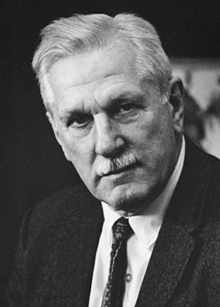Folke K. Skoog
Folke Karl Skoog | |
|---|---|
 | |
| Born | July 15, 1908 Halland,Sweden |
| Died | February 15, 2001(aged 92) |
| Resting place | Uppsala old cemetery,Sweden |
| Alma mater | Caltech |
| Known for | Murashige and Skoog medium |
| Spouse | Birgit Skoog |
| Awards | National Medal of Science(1991) |
| Scientific career | |
| Fields | Plant physiology |
| Institutions | Caltech,Berkeley,University of Hawaiʻi,Harvard,Johns Hopkins University,Washington University in St. Louis,University of Wisconsin |
| Thesis | Some Physiological Functions of the Growth Hormone in Higher Plants(1936) |
| Notable students | Toshio Murashige |
Folke Karl Skoog(July 15, 1908 – February 15, 2001) was a Swedish-born Americanplant physiologistwho was a pioneer in the field of plant growth regulators, particularlycytokinins.Skoog was a recipient of theNational Medal of Science1991.[1][2]
Born inHalland,Sweden, Skoog emigrated to the United States during a trip toCaliforniain 1925, and was naturalized as a citizen almost a decade later. He competed, and finished sixth in heat 2, in the 1500 meter race during the1932 Summer Olympics.[3]In 1936, he received his PhD in biology fromCaltechfor his work done withauxin,a plant hormone.
In 1937, Skoog was apostdoctoral researcherwithDennis Robert Hoagland,and his professional career advanced significantly with his arrival at theUniversity of Wisconsin–Madisonin 1947.Carlos O. Millerdiscoveredkinetinin 1954,[4]andbenzyladenineand related compounds were later synthesized in Skoog's lab.
In 1962, Skoog andToshio Murashigepublished what is probably the best-known paper in plant tissue culture; in a fruitless attempt to discover a yet-unknown plant growth regulator intobaccojuice for his doctoral thesis, Murashige and Skoog instead developed a greatly improved salt base for the sterile culture of tobacco. Now referred to asMurashige and Skoog medium,the final paper (Murashige, T. and Skoog, F. (1962) A revised medium for rapid growth and bioassays with tobacco tissue cultures. Physiol Plant 18: 100-127) is one of the most often-cited papers in biology.[5]Now 60 years after the work, M&S salt base remains an essential component inplant tissue culture,but not inhydroponics.[6]
In 1970, Skoog was elected a foreign member of theRoyal Swedish Academy of Sciences.
References[edit]
- ^Peter V. Minorsky (April 2001)."Tribute to Folke Skoog".Plant Physiology.
{{cite journal}}:Cite journal requires|journal=(help) - ^Folke K. SkoogonNational Science Foundation.
- ^Folke SkoogArchivedOctober 26, 2012, at theWayback Machineon sports-reference
- ^"Richard M. Amasino | Faculty | Biochemistry | UW-Madison"(PDF).3 July 2019.
- ^Richard Van Noorden, Brendan Maher andRegina Nuzzo(29 October 2014)."The top 100 papers".Nature.514(7524). Nature News: 550–553.Bibcode:2014Natur.514..550V.doi:10.1038/514550a.PMID25355343.S2CID4466906.
- ^van Delden, S.H.; Nazarideljou, M.J.; Marcelis, L.F.M. (2020)."Nutrient solutions forArabidopsis thaliana:a study on nutrient solution composition in hydroponics systems ".Plant Methods.16(72): 1–14.doi:10.1186/s13007-020-00606-4.PMC7324969.PMID32612669.
- 1908 births
- 2001 deaths
- Swedish scientists
- California Institute of Technology alumni
- University of Wisconsin–Madison faculty
- National Medal of Science laureates
- Athletes (track and field) at the 1932 Summer Olympics
- Members of the Royal Swedish Academy of Sciences
- Plant physiologists
- Members of the United States National Academy of Sciences
- Olympic athletes for Sweden
- Swedish emigrants to the United States
- Washington University in St. Louis faculty
- Johns Hopkins University faculty
- University of Hawaiʻi at Mānoa faculty
- University of California, Berkeley faculty
- Caltech Beavers men's track and field athletes
- Swedish athletics biography stubs
- European botanist stubs
- Swedish scientist stubs
